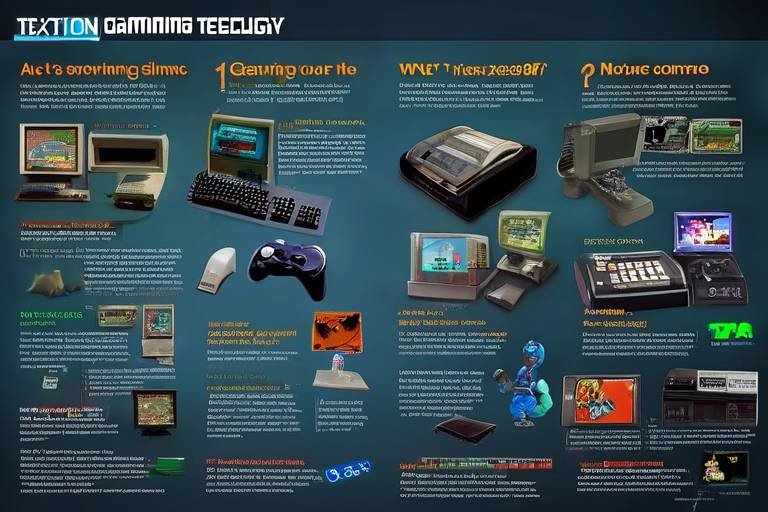The Evolution of Gaming Technology - What’s Next?
The world of gaming technology has undergone a remarkable transformation over the years. From the simplistic pixelated screens of the past to the stunningly immersive experiences we have today, the evolution of gaming is nothing short of extraordinary. As we dive into this fascinating journey, we’ll explore the key milestones that have shaped the gaming landscape and speculate on what the future holds for this dynamic industry. Are you ready to level up your understanding of gaming technology? Let’s get started!
Let’s take a trip down memory lane to the origins of gaming technology. It all began in the early 1970s with the emergence of arcade machines, which captivated players with their simple yet addictive gameplay. These machines laid the groundwork for the first home consoles, like the Atari 2600, which brought gaming into living rooms across the globe. Key innovations during this era included:
- Microprocessors: These tiny chips made it possible for games to become more complex and engaging.
- Color Graphics: The introduction of color graphics transformed the visual appeal of games, making them more attractive to players.
- Home Consoles: The shift from arcade to home gaming allowed players to enjoy their favorite games at their convenience.
These early advancements set the stage for the gaming revolution that was about to unfold, paving the way for the breathtaking experiences we enjoy today.
Fast forward to the 1990s, and we witness a seismic shift in gaming with the introduction of 3D graphics. The transition from 2D to 3D environments was a game-changer, quite literally! Players were no longer confined to flat, two-dimensional landscapes; they could now explore vast, three-dimensional worlds filled with depth and realism. This revolution not only enhanced visual fidelity but also transformed gameplay mechanics, enabling more immersive experiences. Imagine walking through a lush forest or navigating a bustling city—3D graphics made these experiences possible!
Of course, none of this would have been achievable without significant improvements in hardware. Graphics cards and processors have seen remarkable advancements, allowing developers to push the boundaries of what is possible in gaming. Today’s games boast stunning visuals, intricate details, and realistic physics, all thanks to powerful hardware. Consider the leap from the Nintendo 64 to the PlayStation 5; the difference is like comparing a horse and buggy to a rocket ship!
One of the most exciting developments in gaming technology is the rise of virtual reality (VR). This technology has evolved from clunky prototypes to sleek headsets that transport players into entirely new worlds. Imagine donning a headset and being able to explore alien planets or fight dragons as if you were truly there. VR has the potential to create experiences that blur the line between the virtual and real worlds, offering players an unprecedented level of immersion.
But wait, there’s more! Augmented reality (AR) is also set to change the gaming landscape. Unlike VR, which immerses players in a completely virtual environment, AR integrates digital elements into the real world. Think of games like Pokémon GO, where players interact with digital creatures in their actual surroundings. The possibilities for AR in gaming are endless, enhancing gameplay and interaction in ways we’ve only begun to explore.
As technology has advanced, so too has the way we connect and play. The rise of online gaming has transformed the gaming experience, allowing players from around the world to join forces or compete against each other in real-time. This connectivity has fostered a sense of community among gamers, making it easier than ever to find friends and rivals alike. With the advent of high-speed internet, multiplayer experiences have evolved dramatically, offering rich, dynamic interactions that were once unimaginable.
Artificial intelligence (AI) is another game-changer in the world of gaming. AI is being integrated into games to enhance non-player character (NPC) behavior, create dynamic environments, and personalize player experiences. Imagine playing a game where the NPCs react intelligently to your actions, making each playthrough unique. AI-driven game design is paving the way for more engaging and interactive experiences, allowing players to feel truly immersed in the game world.
One exciting application of AI is procedural generation, which allows developers to create vast, unpredictable game worlds. This technique generates content algorithmically, offering players unique experiences every time they play. Think of it as a digital snowflake—no two experiences are ever the same! This not only increases replayability but also keeps players engaged as they explore new landscapes and challenges.
Furthermore, AI is influencing the game design process itself. From creating realistic character behaviors to optimizing game balance and difficulty levels, AI is helping developers craft tailored experiences that resonate with players. It’s like having a personal game designer who knows exactly what you enjoy and adjusts the game accordingly!
So, what does the future hold for gaming technology? Speculation abounds, but a few trends seem likely to shape the industry in the coming years:
- Cloud Gaming: This technology promises to make high-quality gaming accessible to anyone with an internet connection, eliminating the need for expensive hardware.
- Cross-Platform Play: Players will increasingly be able to enjoy games across different devices, fostering a more inclusive gaming community.
- Immersive Experiences: Emerging technologies like AI, VR, and AR will continue to push the boundaries of immersion, creating experiences that feel more real than ever.
The evolution of gaming technology is a thrilling journey, and we’re only just beginning to scratch the surface of what’s possible. Buckle up, because the future of gaming is sure to be an exhilarating ride!
Q1: What was the first home video game console?
A1: The first home video game console was the Magnavox Odyssey, released in 1972.
Q2: How has virtual reality changed gaming?
A2: Virtual reality has provided players with immersive experiences that allow them to feel as if they are inside the game world, enhancing gameplay and engagement.
Q3: What are the benefits of cloud gaming?
A3: Cloud gaming allows players to access high-quality games without the need for expensive hardware, making gaming more accessible to a wider audience.
Q4: How does AI improve gaming experiences?
A4: AI enhances gaming by creating intelligent NPCs, personalizing player experiences, and generating content that keeps gameplay fresh and engaging.

The Birth of Gaming Technology
The journey of gaming technology is nothing short of a thrilling adventure that has captivated millions around the globe. It all began in the 1970s, a time when the idea of interactive entertainment was still in its infancy. The first sparks of innovation ignited with simple arcade machines, where players could engage in rudimentary games like Pong and Space Invaders. These games, with their pixelated graphics and addictive gameplay, laid the groundwork for what was to come.
As the 1980s rolled in, home consoles started to make their debut, allowing players to enjoy video games right in the comfort of their living rooms. The release of the Atari 2600 in 1977 marked a monumental shift in gaming culture, introducing cartridge-based games that offered a variety of experiences. This was a game-changer, quite literally! Families gathered around their television sets, controllers in hand, experiencing the magic of gaming together.
Throughout the years, several key innovations emerged that would shape the future of gaming technology:
- Graphics Advancements: From 8-bit graphics to 16-bit and beyond, visual fidelity improved dramatically, enhancing the gaming experience.
- Sound Technology: The introduction of stereo sound and digital audio brought games to life, making the experience more immersive.
- Multiplayer Capabilities: The shift from single-player experiences to multiplayer games began to forge connections between players, paving the way for the online gaming revolution.
These innovations were not just technological feats; they represented a cultural shift. Gaming became a social activity, a way to bond with friends and family. The release of the Nintendo Entertainment System (NES) in the mid-1980s solidified this trend, introducing iconic franchises like Super Mario and The Legend of Zelda. These games didn't just entertain; they created legends, giving birth to a community of gamers who would passionately debate strategies and share experiences.
As the industry evolved, so did the technology behind it. The introduction of CD-ROMs in the 1990s allowed for larger games with richer content, leading to the creation of immersive worlds that players could explore. Titles like Final Fantasy VII and Doom showcased what was possible when developers pushed the limits of technology.
Today, we stand on the shoulders of these early pioneers, witnessing the transformation of gaming into a multi-billion dollar industry. The birth of gaming technology was just the beginning; it set the stage for what would become a vibrant and ever-evolving landscape. As we delve deeper into the history and advancements of gaming, it becomes clear that each innovation is a stepping stone towards a future filled with possibilities.

The Rise of 3D Graphics
The evolution of gaming technology has been nothing short of a thrilling rollercoaster ride, and at the heart of this transformation lies the incredible rise of 3D graphics. Imagine stepping into a world where the characters you control are not just flat images but fully realized beings moving through a rich, immersive environment. This leap from 2D to 3D was a game-changer, reshaping how players interact with virtual worlds. Remember the days when games were primarily pixelated sprites? Those days are long gone, replaced by stunning three-dimensional landscapes that offer players a sense of depth and realism that was previously unimaginable.
Initially, 3D graphics made their debut in the early 1990s with titles like Wolfenstein 3D and Doom. These games introduced players to a new dimension of gameplay, quite literally! The shift to 3D allowed for more complex level designs, enabling players to explore intricate environments rather than merely moving from left to right on a screen. This change not only enhanced the visual appeal but also influenced gameplay mechanics, paving the way for genres like first-person shooters and open-world adventures.
As technology progressed, the impact of 3D graphics became even more pronounced. The introduction of powerful graphics processing units (GPUs) revolutionized the gaming landscape. No longer were developers limited by the constraints of hardware; they could now create expansive worlds filled with detailed textures, realistic lighting, and lifelike animations. The result? Games that not only looked stunning but also felt alive. Titles such as The Legend of Zelda: Ocarina of Time and Final Fantasy VII showcased the potential of 3D graphics, captivating players with their storytelling and visual artistry.
One of the most exciting aspects of this evolution has been the way 3D graphics have transformed player experiences. With the advent of 3D environments, players are no longer passive observers; they are active participants in a vibrant world. The ability to explore, interact, and engage with the environment has created a deeper emotional connection to the game. Think about it: when you can physically navigate a space, the stakes feel higher, and the immersion is unparalleled.
The rise of 3D graphics also paved the way for innovative gameplay mechanics. For instance, the introduction of camera angles and perspectives has allowed developers to craft unique narratives and gameplay experiences. Players can now experience a story from various viewpoints, making each journey feel personal and tailored to their preferences. This is particularly evident in games like Grand Theft Auto V, where players can switch between characters and perspectives, enriching the overall narrative.
However, the journey of 3D graphics is far from over. As technology continues to advance, we are on the verge of even more groundbreaking innovations. With the rise of ray tracing, for instance, games are beginning to exhibit realistic lighting effects that mimic the behavior of light in the real world. This level of detail not only enhances the visual fidelity but also deepens the sense of realism, making players feel like they are truly part of the game.
In summary, the rise of 3D graphics has fundamentally changed the gaming landscape, transforming not just how games look, but how they feel and are played. As we look to the future, one can't help but wonder what the next leap in graphics technology will bring. Will we see even more lifelike avatars? Or perhaps worlds so immersive that the line between reality and gaming blurs even further? The possibilities are endless, and as gamers, we are fortunate to be part of this incredible journey.
- What was the first 3D game? The first widely recognized 3D game is Wolfenstein 3D, released in 1992.
- How have 3D graphics evolved over the years? 3D graphics have evolved from simple polygonal shapes to highly detailed, realistic environments with advanced lighting and textures.
- What is ray tracing? Ray tracing is a rendering technique that simulates the way light interacts with objects, creating realistic lighting effects in 3D environments.

The Role of Hardware Advancements
The evolution of gaming technology has been significantly influenced by hardware advancements, which have played a pivotal role in transforming the gaming landscape. Just think back to the early days of gaming, where pixelated graphics and simplistic gameplay were the norms. Fast forward to today, and we are living in a world where stunning visuals and immersive experiences are not just dreams but realities. Hardware advancements have been the driving force behind this transformation, enabling developers to create games that are not only visually appealing but also rich in content and complexity.
At the heart of this revolution are graphics cards and processors. These components have undergone remarkable changes over the years, allowing for higher frame rates, better resolutions, and more detailed textures. For instance, the introduction of ray tracing technology has brought about a new level of realism in lighting and shadows, making virtual worlds feel more alive than ever. This level of detail enhances player immersion, drawing them deeper into the game. Imagine walking through a forest in a game where the sunlight filters through the leaves just like it does in real life—this is the magic that advanced hardware brings to the table.
Moreover, the rise of solid-state drives (SSDs) has revolutionized load times. Gone are the days of waiting impatiently for a game to boot up or for a level to load. With SSDs, players can jump straight into action, enhancing the overall gaming experience. The difference between traditional hard drives and SSDs is akin to comparing a snail to a cheetah; the speed is just that dramatic! This improvement in load times not only benefits individual players but also enhances the social aspect of gaming, particularly in multiplayer environments where quick access can mean the difference between victory and defeat.
Additionally, the advancement of virtual reality (VR) hardware has opened up new dimensions in gaming. With the development of lightweight headsets and motion tracking technology, players can now physically engage with their games, making the experience more interactive and enjoyable. Picture yourself wielding a sword in a fantasy world, your movements mirrored in real-time by your character—this level of engagement is something that traditional gaming simply cannot match. As VR technology continues to evolve, we can expect even more groundbreaking experiences that push the boundaries of what we consider gaming.
Furthermore, the rise of cloud gaming is another testament to how hardware advancements are reshaping the industry. With powerful servers handling the heavy lifting, players can enjoy high-quality games on less powerful devices. This democratization of gaming means that anyone, regardless of their hardware setup, can access top-tier gaming experiences. It’s like having a high-end gaming rig in your pocket—who wouldn’t want that?
In conclusion, the role of hardware advancements in gaming cannot be overstated. They have not only enhanced the visual and interactive aspects of games but have also made gaming more accessible to a broader audience. As technology continues to evolve, we can only imagine what the future holds. Will we see even more realistic graphics? Will virtual reality become the norm? One thing is for sure: the journey of gaming technology is far from over, and we are all excited to see where it leads us next.
- What are the main components that influence gaming performance?
The main components include the graphics card, processor, RAM, and storage type (SSD vs. HDD). Each plays a crucial role in determining how smoothly a game runs and its visual quality.
- How does virtual reality enhance the gaming experience?
Virtual reality immerses players in a 3D environment, allowing them to interact with the game world in a more physical and engaging way, which traditional gaming cannot replicate.
- What is cloud gaming and how does it work?
Cloud gaming allows players to stream games over the internet from powerful servers, meaning they can play high-quality games on devices that may not have the hardware to run them locally.

The Impact of Virtual Reality
Virtual Reality (VR) has emerged as a game-changer in the world of gaming, transforming not just how we play, but how we experience virtual worlds. Imagine slipping on a headset and being transported to a completely different universe, where you can interact with your surroundings in ways that were once only possible in science fiction. This immersive technology takes gaming to an entirely new level, allowing players to feel as if they are truly part of the game. But how did we get here, and what does the future hold?
The journey of VR began with the concept of creating an immersive experience that engages multiple senses. Early attempts in the 1960s and 70s were rudimentary, often involving bulky equipment and limited graphics. However, the foundation was laid for what would evolve into the sophisticated systems we see today. Fast forward to the 21st century, and we now have sleek headsets like the Oculus Rift, HTC Vive, and PlayStation VR, which offer stunning visuals and responsive controls that can make you feel like you're standing on the edge of a cliff or exploring an alien planet.
One of the most significant impacts of VR is its ability to create emotional connections between players and the game world. In traditional gaming, players often felt detached from the narrative, but with VR, they can become active participants in the story. For instance, in games like Half-Life: Alyx, players can physically interact with objects, solve puzzles, and engage with characters, making every decision feel critical. This level of engagement not only enhances enjoyment but also fosters a deeper understanding of the game's narrative and emotional weight.
Moreover, VR has opened doors to entirely new genres of gaming. Take simulation games, for example. With VR, players can pilot a spaceship, drive a race car, or even engage in combat scenarios with a realism that was previously unimaginable. The technology has also made strides in educational and training applications, allowing users to practice skills in a safe, controlled environment. Imagine a surgeon practicing complex procedures or a firefighter training for emergency situations—all in virtual settings that mimic real-life challenges.
However, the impact of VR goes beyond just gaming. It has the potential to revolutionize social interactions within the gaming community. Platforms like VRChat allow users to meet and interact in virtual spaces, breaking down geographical barriers and creating a sense of presence that traditional online gaming lacks. Players can attend virtual concerts, explore art galleries, or simply hang out with friends in a shared digital space, making gaming a more social experience.
As we look to the future, the possibilities for VR in gaming are boundless. Developers are continuously pushing the envelope, creating more realistic environments, improving haptic feedback, and integrating AI-driven narratives that adapt to player choices. With advancements in technology, we can expect even more immersive experiences that blur the line between reality and the virtual world.
Ultimately, the impact of virtual reality on gaming is profound and far-reaching. It has changed the way we play, interact, and engage with stories. As we continue to explore the potential of VR, we can only imagine the incredible experiences that await us. Will you be ready to step into the future of gaming?
- What is Virtual Reality? - Virtual Reality is a simulated experience that can be similar to or completely different from the real world, achieved through the use of technology such as VR headsets.
- How does VR enhance gaming? - VR enhances gaming by providing immersive environments where players can interact with the game world in a more physical and emotional way.
- Are there any health concerns with VR gaming? - Some users may experience motion sickness or eye strain. It's important to take breaks and ensure the setup is comfortable.
- What are some popular VR games? - Popular VR games include Beat Saber, Half-Life: Alyx, and Boneworks.

The Future of Augmented Reality
As we stand on the brink of a new era in gaming, augmented reality (AR) is set to play a pivotal role in shaping how we interact with our favorite games. Imagine a world where your living room transforms into a battlefield, or your local park becomes a treasure hunt filled with digital creatures waiting to be captured. This is not just a dream; it's the exciting potential of augmented reality!
AR technology superimposes digital content onto the real world, creating a seamless blend of the virtual and the physical. Companies like Niantic, known for their hit game Pokémon GO, have already demonstrated how AR can encourage players to explore their surroundings while engaging with digital elements. This trend is only going to grow stronger as technology advances.
One of the most significant advancements in AR is the development of smart glasses and headsets that can enhance the gaming experience. Unlike traditional gaming setups, these devices allow players to immerse themselves in a game without being tethered to a screen. For instance, imagine wearing a pair of sleek glasses that overlay game graphics onto your environment, allowing you to interact with characters and objects as if they were right in front of you. The potential for social interaction is immense, as players can engage with each other in real-time, regardless of their physical location.
Moreover, the integration of AR in gaming is expected to lead to more interactive storytelling. Game developers can create narratives that evolve based on players' real-world actions. For example, a game could change its plotline based on where you are or what you do in your everyday life. This level of personalization can make gaming experiences feel more relevant and engaging, drawing players deeper into the story.
However, the future of AR in gaming is not without its challenges. Technical limitations such as battery life, processing power, and the need for robust internet connectivity can hinder the widespread adoption of AR gaming. As developers work to overcome these obstacles, we can expect to see innovations that make AR more accessible and enjoyable for everyone.
In summary, the future of augmented reality in gaming is bright and full of possibilities. As technology continues to evolve, we can look forward to experiences that not only entertain but also enrich our interactions with the world around us. With AR, the line between reality and gaming will blur, creating immersive experiences that redefine what it means to play.
- What is augmented reality (AR)?
Augmented reality is a technology that overlays digital information, such as images or sounds, onto the real world, enhancing the user's perception of their environment.
- How does AR differ from virtual reality (VR)?
While VR immerses users in a completely virtual environment, AR enhances the real world by adding digital elements to it.
- What are some examples of AR games?
Popular AR games include Pokémon GO, Ingress, and Harry Potter: Wizards Unite, which blend gameplay with real-world exploration.
- What future advancements can we expect in AR gaming?
Future advancements may include more sophisticated AR devices, improved graphics, and deeper integration of AR into everyday life, making games more interactive and engaging.

Online Gaming and Connectivity
Online gaming has transformed the way we interact with games and each other, creating a vibrant community that transcends geographical boundaries. Remember the days when gaming was a solitary experience, confined to the living room? Well, those days are long gone! Today, thanks to the power of the internet, players can connect with friends and strangers alike, forming teams, competing in tournaments, and sharing experiences in real-time.
The rise of online gaming has not only changed how we play but also how we think about gaming as a social activity. Players now have the ability to team up with others from around the globe, leading to the emergence of online communities that thrive on collaboration and competition. This connectivity has introduced various genres that emphasize multiplayer experiences, such as battle royale games, MMOs (Massively Multiplayer Online games), and co-op adventures. These games have become cultural phenomena, with millions of players logging in daily to engage with their favorite titles.
Furthermore, the technological advancements in internet connectivity have played a significant role in this evolution. With the advent of high-speed broadband and the widespread availability of Wi-Fi, gamers can enjoy seamless experiences without the lag that once plagued online play. The introduction of cloud gaming services has further revolutionized the landscape, allowing players to access games from anywhere without the need for powerful hardware. This means that even those with modest setups can experience the latest titles, leveling the playing field and expanding the gaming community.
As we look to the future, the potential for online gaming and connectivity seems boundless. Imagine a world where virtual reality and augmented reality merge with online gaming, creating immersive experiences that allow players to interact in ways we can only dream of today. Picture yourself exploring a fantastical world alongside friends, all from the comfort of your own home, while feeling as if you’re truly there together. The possibilities are endless!
In summary, online gaming has not only redefined how we play games but has also created a global community that thrives on connectivity and collaboration. As technology continues to advance, we can expect even more innovative ways to connect and engage with one another in the gaming world.
- What is online gaming? Online gaming refers to playing video games over the internet, allowing players to connect and interact with others globally.
- How has online gaming changed over the years? Online gaming has evolved from simple multiplayer experiences to complex, immersive environments with millions of players interacting in real-time.
- What technologies have impacted online gaming? High-speed internet, cloud gaming, and advancements in hardware have significantly enhanced the online gaming experience.
- Will online gaming continue to grow? Yes! As technology advances, we can expect more innovative features and experiences in online gaming.

The Role of Artificial Intelligence
Artificial Intelligence (AI) has become a game-changer in the world of gaming, fundamentally altering how players interact with games and how developers create them. Imagine stepping into a game where the non-playable characters (NPCs) respond to your actions with a level of realism that makes you question whether you’re interacting with a programmed entity or a real person. This is the magic of AI in gaming. It’s not just about creating smarter enemies or more engaging allies; it’s about crafting entire worlds that feel alive.
At its core, AI enhances NPC behavior, making characters more responsive and dynamic. For instance, in open-world games, AI algorithms can dictate how NPCs react to player actions, creating a more immersive experience. Instead of following a fixed script, these characters can adapt to the player’s style, making every encounter unique. This level of interactivity keeps players on their toes and adds a layer of depth to gameplay that was previously unimaginable.
Moreover, AI contributes to the creation of dynamically generated environments. Through procedural generation, developers can use AI to create vast, unpredictable game worlds that offer players a new experience with each playthrough. This technology not only enhances replayability but also allows for the creation of environments that feel organic and less scripted. For instance, a player might explore a forest that changes its layout or weather conditions based on their previous actions, leading to a truly personalized adventure.
Another exciting aspect of AI in gaming is its role in personalizing player experiences. By analyzing player behavior, AI can adjust game difficulty, suggest in-game content, or even tailor storylines to fit individual preferences. This means that two players can have vastly different experiences in the same game, enhancing engagement and satisfaction. Imagine a game that learns your play style and adjusts the challenges you face accordingly—this is not just a fantasy; it’s becoming a reality.
However, the integration of AI in gaming also raises questions about balance and fairness. Developers must ensure that AI doesn’t create an experience that feels rigged or unfair. For example, if an AI-controlled enemy knows your every move, it could lead to frustration rather than fun. Thus, finding the right balance is crucial. Developers are increasingly using AI to optimize game balance, ensuring that challenges are engaging without becoming overwhelming.
| AI Applications in Gaming | Description |
|---|---|
| NPC Behavior | Improves realism and interactivity of characters. |
| Procedural Generation | Creates vast, unpredictable environments for increased replayability. |
| Personalization | Tailors experiences based on player behavior and preferences. |
| Game Balance | Ensures challenges are engaging without being frustrating. |
As we look to the future, the role of AI in gaming will only expand. With advancements in machine learning and data analysis, we can expect even more sophisticated AI systems that can learn and adapt in real time. Imagine a game that evolves based on the collective actions of its player base, creating a living world that grows and changes with its community. This could redefine not just how we play games, but how we experience them together.
In conclusion, AI is not just a tool; it’s a revolutionary force in the gaming industry. It enriches gameplay, enhances storytelling, and personalizes experiences, making games more engaging and immersive than ever before. As developers continue to push the boundaries of what AI can do, the future of gaming looks brighter and more exciting than we could have ever imagined.
- How does AI improve NPC behavior? AI allows NPCs to respond dynamically to player actions, making interactions feel more realistic and engaging.
- What is procedural generation? Procedural generation uses algorithms to create game content algorithmically, leading to unique environments and experiences for players.
- Can AI personalize my gaming experience? Yes! AI can analyze your play style and adjust game elements to offer a tailored experience that suits your preferences.
- Will AI make games too difficult? Developers are working to ensure that AI enhances challenge without overwhelming players, maintaining a balance for enjoyable gameplay.

Procedural Generation in Games
When you think about the vast, sprawling worlds in modern video games, it's easy to feel overwhelmed by the sheer size and complexity of these environments. This is where procedural generation comes into play, a technique that uses algorithms to create game content dynamically rather than relying solely on hand-crafted designs. Imagine a world that can generate itself as you explore it, like a book that writes itself based on your choices. This innovative approach has revolutionized the gaming landscape, offering players unique experiences every time they play.
At its core, procedural generation allows developers to create expansive game worlds without the immense labor of designing every detail manually. For instance, in games like No Man's Sky, entire planets are generated on-the-fly, featuring diverse ecosystems, landscapes, and even unique wildlife. This not only increases the replayability of a game but also immerses players in a living, breathing universe. The beauty of procedural generation lies in its ability to produce content that feels fresh and unpredictable, making every player's journey a unique adventure.
However, the magic of procedural generation doesn't stop at just creating vast terrains. It can also be applied to various game elements, such as quests, items, and even NPC behaviors. By utilizing algorithms to determine how these elements interact, developers can create a dynamic ecosystem where no two playthroughs are ever the same. For example, in a role-playing game, the quests can be generated based on the player's previous actions, leading to a more personalized gaming experience that feels tailored just for you.
To better illustrate the impact of procedural generation, consider the following table that outlines some of its key benefits:
| Benefit | Description |
|---|---|
| Replayability | Each playthrough offers a unique experience, encouraging players to return. |
| Resource Efficiency | Reduces the time and manpower needed to create vast game worlds. |
| Diverse Content | Generates a wide variety of environments, quests, and items, enhancing player engagement. |
Despite its many advantages, procedural generation isn't without its challenges. Developers must strike a balance between randomness and coherence; if the generated content is too chaotic, it can lead to a frustrating experience for players. It's like baking a cake—too much of one ingredient can ruin the entire dish. Therefore, developers often implement rules and constraints within their algorithms to ensure that the generated content remains enjoyable and engaging.
As we look to the future, the potential for procedural generation in games is boundless. With advancements in artificial intelligence and machine learning, we can expect even more sophisticated algorithms that can create richer, more immersive worlds. Imagine stepping into a game where the environment not only changes based on your actions but also learns from your play style, adapting to offer challenges that are perfectly suited to your skills. This is the exciting frontier of procedural generation, and it's just the beginning of what gaming can achieve.
- What is procedural generation?
Procedural generation is a method of creating data algorithmically as opposed to manually, allowing for dynamic and varied content in games.
- How does procedural generation enhance replayability?
Since the content is generated differently each time, players can experience new challenges and environments on subsequent playthroughs.
- Are there any downsides to procedural generation?
Yes, if not implemented carefully, it can lead to incoherent or chaotic game environments that detract from the player experience.

AI-Driven Game Design
In the realm of gaming, artificial intelligence is not just a buzzword; it's a revolutionary force that is reshaping how games are designed and experienced. Imagine playing a game where every character you encounter behaves uniquely, adapting to your choices and strategies. This is the power of AI-driven game design, and it's transforming the landscape of interactive entertainment.
One of the most exciting aspects of AI in game design is its ability to create realistic character behaviors. Gone are the days when non-player characters (NPCs) followed a fixed script, merely reacting to player actions in predictable ways. Now, with sophisticated algorithms, NPCs can learn from player interactions, making them more dynamic and engaging. For instance, if you consistently choose a stealthy approach in a game, the AI can adjust the NPCs' responses, making them more vigilant and challenging.
Moreover, AI is enhancing the overall game balance and difficulty levels. Developers can use machine learning algorithms to analyze player data and adjust the game's difficulty in real-time. This means that if a player is breezing through levels too easily, the AI can ramp up the challenge, ensuring a more tailored and satisfying experience. Conversely, if a player struggles, the AI can provide subtle hints or adjust enemy strength, creating a balanced gameplay experience that keeps players engaged without feeling frustrated.
To illustrate the impact of AI-driven design, consider the following table that highlights key advantages:
| Advantage | Description |
|---|---|
| Dynamic NPC Behavior | Characters that adapt to player choices, creating a more immersive experience. |
| Real-time Difficulty Adjustment | AI analyzes player performance to modify game challenges on the fly. |
| Enhanced Storytelling | AI can generate branching narratives based on player decisions, leading to unique story arcs. |
| Procedural Content Generation | AI can create vast, unpredictable worlds and scenarios, ensuring high replayability. |
Additionally, AI's role in procedural generation cannot be overlooked. This technique allows for the creation of expansive game worlds that are not only diverse but also unpredictable. By using AI algorithms, developers can generate landscapes, quests, and even entire ecosystems that change with every playthrough. This not only enhances the player's experience but also significantly increases the game's replayability. Imagine a game where no two playthroughs are the same—each journey feels fresh and exciting!
As we look to the future, the integration of AI in game design will likely expand even further. Developers are constantly exploring new ways to leverage AI, from creating more complex narratives to designing intricate game mechanics that respond to player behavior. The potential is enormous, and as technology advances, we can expect to see games that are not only visually stunning but also deeply engaging on an emotional and intellectual level.
In conclusion, AI-driven game design is paving the way for a new era in gaming. By enhancing character interactions, balancing gameplay, and generating unique content, AI is not just a tool but a co-creator in the gaming universe. As players, we can look forward to a future where our choices profoundly impact the game world, making each experience uniquely ours.
- What is AI-driven game design? AI-driven game design refers to the use of artificial intelligence technologies to create more dynamic and responsive game environments, enhancing player experiences through realistic NPC behavior and adaptive difficulty levels.
- How does AI improve NPC behavior? AI allows NPCs to learn from player actions and adapt their strategies accordingly, making interactions more engaging and less predictable.
- Can AI create unique game worlds? Yes, through procedural generation, AI can create diverse and unique game worlds that offer different experiences with each playthrough.
- Is AI the future of gaming? Many experts believe that AI will play a crucial role in the future of gaming, enhancing storytelling, gameplay mechanics, and overall player engagement.

Looking Ahead: The Future of Gaming
As we stand on the brink of a new era in gaming, the possibilities seem limitless. With technology evolving at a breakneck pace, it's fascinating to ponder what the future holds for gamers and developers alike. Imagine a world where cloud gaming becomes the norm, allowing players to access high-quality games without the need for expensive hardware. This shift could democratize gaming, making it accessible to anyone with an internet connection, regardless of their device's specifications.
Furthermore, we can expect cross-platform play to become a standard feature in many games. This means that whether you're on a console, PC, or mobile device, you can connect and compete with friends seamlessly. The barriers that once separated gaming communities are slowly dissolving, paving the way for more inclusive and engaging multiplayer experiences. The future might even see the rise of social gaming, where players can interact not just through gameplay but also through shared experiences and virtual events.
Another exciting development is the potential for even more immersive experiences through emerging technologies. Virtual reality (VR) and augmented reality (AR) are already making waves, but what if we could take it a step further? Imagine stepping into your favorite game, feeling the environment around you, and interacting with it in real-time. This isn’t just a dream; it’s a reality that’s slowly taking shape as hardware and software become more sophisticated.
One aspect that cannot be overlooked is the integration of artificial intelligence in gaming. AI is already enhancing NPC behavior and creating dynamic environments. In the future, we might see AI-driven narratives that adapt to player choices, offering a unique experience each time you play. This could lead to games that not only entertain but also challenge players in ways we’ve never seen before, making every session feel fresh and exciting.
In terms of game design, we can anticipate a shift towards procedural generation. This technology allows developers to create expansive worlds filled with unpredictable elements, ensuring that no two gaming sessions are the same. It increases replayability and keeps players engaged by offering new challenges and adventures with each playthrough. Imagine exploring a vast universe where every planet is uniquely generated, filled with diverse ecosystems and creatures that react to your actions.
As we look ahead, it's crucial to consider the role of community in shaping the future of gaming. With platforms like Twitch and Discord, gamers are more connected than ever. The future of gaming will likely see even more collaborative efforts, where players can contribute to game development, share ideas, and influence the direction of their favorite franchises. This level of involvement could lead to games that truly reflect the desires and interests of the gaming community.
In conclusion, the future of gaming is bright, filled with potential advancements that promise to transform the way we play, interact, and experience games. As technology continues to evolve, so too will our experiences as gamers. Are you ready to embrace the future?
- What is cloud gaming? Cloud gaming allows players to stream games over the internet without needing powerful hardware, as the processing is done on remote servers.
- How will cross-platform play affect gaming? Cross-platform play will enable players on different devices to interact and compete with each other, fostering a more inclusive gaming community.
- What role does AI play in future gaming? AI will enhance gameplay by creating more realistic NPC behaviors, dynamic environments, and personalized experiences based on player choices.
- What is procedural generation? Procedural generation is a method used to create content algorithmically, resulting in unique game worlds that offer endless replayability.
Frequently Asked Questions
- What were the first gaming technologies?
The journey of gaming technology began with simple arcade machines in the late 1970s, such as Pong, which introduced the concept of interactive entertainment. This was followed by the first home consoles like the Atari 2600, which allowed players to enjoy games in the comfort of their homes, paving the way for the gaming industry we know today.
- How did 3D graphics change gaming?
The transition from 2D to 3D graphics was a game-changer, quite literally! It added depth and realism to gaming environments, making experiences more immersive. Players could explore vast worlds and engage in more complex gameplay, which fundamentally changed how games were designed and enjoyed.
- What role does hardware play in gaming advancements?
Hardware advancements, like powerful graphics cards and processors, have been crucial in enabling developers to create more complex and visually stunning games. These improvements allow for higher frame rates, better graphics, and more detailed environments, pushing the boundaries of what players can experience.
- What is the significance of virtual reality in gaming?
Virtual reality (VR) technology has the potential to create incredibly immersive gaming experiences. By simulating a 3D environment, VR allows players to feel as though they are part of the game, leading to a more engaging and interactive experience that blurs the line between the virtual and real worlds.
- How is augmented reality changing the gaming landscape?
Augmented reality (AR) is revolutionizing gaming by overlaying digital elements onto the real world. This integration enhances gameplay by allowing players to interact with both digital and physical elements, creating a unique and engaging experience that encourages exploration and interaction in their own environments.
- What impact has online gaming had on player engagement?
Online gaming has transformed how players engage with games, enabling multiplayer experiences that connect people across the globe. This connectivity fosters community, competition, and collaboration, changing the way we think about gaming as a social activity.
- How is artificial intelligence used in gaming?
Artificial intelligence (AI) enhances gaming by improving non-player character (NPC) behavior, creating dynamic environments, and personalizing player experiences. This leads to deeper engagement and more realistic interactions, making games feel more alive and responsive to player actions.
- What is procedural generation in games?
Procedural generation refers to the algorithmic creation of game content, allowing for vast and unpredictable game worlds. This technique increases replayability by offering unique experiences each time a player engages with the game, making every playthrough feel fresh and exciting.
- How is AI influencing game design processes?
AI is significantly influencing game design by optimizing character behaviors, balancing gameplay, and even aiding in storytelling. This allows developers to create more nuanced and tailored experiences, ensuring that players face challenges that are well-suited to their skills and preferences.
- What does the future hold for gaming technology?
The future of gaming technology looks bright with advancements in cloud gaming, cross-platform play, and even more immersive experiences through emerging technologies. As these trends continue to evolve, players can expect more seamless, engaging, and interconnected gaming experiences that redefine entertainment.



















